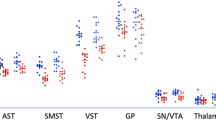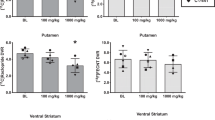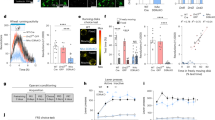Abstract
Neuroimaging studies in humans have demonstrated that inflammatory cytokines target basal ganglia function and presynaptic dopamine (DA), leading to symptoms of depression. Cytokine-treated nonhuman primates also exhibit evidence of altered DA metabolism in association with depressive-like behaviors. To further examine cytokine effects on striatal DA function, eight rhesus monkeys (four male, four female) were administered interferon (IFN)-α (20 MIU/m2 s.c.) or saline for 4 weeks. In vivo microdialysis was used to investigate IFN-α effects on DA release in the striatum. In addition, positron emission tomography (PET) with [11C]raclopride was used to examine IFN-α-induced changes in DA2 receptor (D2R) binding potential before and after intravenous amphetamine administration. DA transporter binding was measured by PET using [18F]2β-carbomethoxy-3β-(4-chlorophenyl)-8-(2-fluoroethyl)nortropane. Anhedonia-like behavior (sucrose consumption) was assessed during saline and IFN-α administration. In vivo microdialysis demonstrated decreased release of DA after 4 weeks of IFN-α administration compared with saline. PET neuroimaging also revealed decreased DA release after 4 weeks of IFN-α as evidenced by reduced displacement of [11C]raclopride following amphetamine administration. In addition, 4 weeks of IFN-α was associated with decreased D2R binding but no change in the DA transporter. Sucrose consumption was reduced during IFN-α administration and was correlated with decreased DA release at 4 weeks as measured by in vivo microdialysis. Taken together, these findings indicate that chronic peripheral IFN-α exposure reduces striatal DA release in association with anhedonia-like behavior in nonhuman primates. Future studies examining the mechanisms of cytokine effects on DA release and potential therapeutic strategies to reverse these changes are warranted.
Similar content being viewed by others
Log in or create a free account to read this content
Gain free access to this article, as well as selected content from this journal and more on nature.com
or
References
Anisman H, Merali Z (2003). Cytokines, stress and depressive illness: brain-immune interactions. Ann Med 35: 2–11.
Anzalone A, Lizardi-Ortiz JE, Ramos M, De Mei C, Hopf FW, Iaccarino C et al (2012). Dual control of dopamine synthesis and release by presynaptic and postsynaptic dopamine D2 receptors. J Neurosci 32: 9023–9034.
Bora E, Harrison BJ, Davey CG, Yucel M, Pantelis C (2012). Meta-analysis of volumetric abnormalities in cortico-striatal-pallidal-thalamic circuits in major depressive disorder. Psychol Med 42: 671–681.
Brydon L, Harrison NA, Walker C, Steptoe A, Critchley HD (2008). Peripheral inflammation is associated with altered substantia nigra activity and psychomotor slowing in humans. Biol Psychiatry 63: 1022–1029.
Bull SJ, Huezo-Diaz P, Binder EB, Cubells JF, Ranjith G, Maddock C et al (2008). Functional polymorphisms in the interleukin-6 and serotonin transporter genes, and depression and fatigue induced by interferon-alpha and ribavirin treatment. Mol Psychiatry 14: 1095–1104.
Capuron L, Gumnick JF, Musselman DL, Lawson DH, Reemsnyder A, Nemeroff CB et al (2002). Neurobehavioral effects of interferon-alpha in cancer patients: phenomenology and paroxetine responsiveness of symptom dimensions. Neuropsychopharmacology 26: 643–652.
Capuron L, Pagnoni G, Demetrashvili M, Woolwine BJ, Nemeroff CB, Berns GS et al (2005). Anterior cingulate activation and error processing during interferon-alpha treatment. Biol Psychiatry 58: 190–196.
Capuron L, Schroecksnadel S, Feart C, Aubert A, Higueret D, Barberger-Gateau P et al (2011). Chronic low-grade inflammation in elderly persons is associated with altered tryptophan and tyrosine metabolism: role in neuropsychiatric symptoms. Biol Psychiatry 70: 175–182.
Capuron L, Pagnoni G, Demetrashvili MF, Lawson DH, Fornwalt FB, Woolwine B et al (2007). Basal ganglia hypermetabolism and symptoms of fatigue during interferon-alpha therapy. Neuropsychopharmacology 32: 2384–2392.
Capuron L, Pagnoni G, Drake DF, Woolwine BJ, Spivey JR, Crowe RJ et al (2012). Dopaminergic mechanisms of reduced basal ganglia responses to hedonic reward during interferon alfa administration. Arch Gen Psychiatry 69: 1044–1053.
Carlsson A, Kehr W, Lindqvist M (1976). The role of intraneuronal amine levels in the feedback control of dopamine, noradrenaline and 5-hydroxytryptamine synthesis in rat brain. J Neural Transm 39: 1–19.
Chaudhury D, Walsh JJ, Friedman AK, Juarez B, Ku SM, Koo JW et al (2013). Rapid regulation of depression-related behaviours by control of midbrain dopamine neurons. Nature 493: 532–536.
Cohen JD (1988) Statistical Power Analysis for the Behavioral Sciences 2nd edn Hillsdale, NJ: Lawrence Erlbaum Associates.
Czoty PW, Justice JB Jr., Howell LL (2000). Cocaine-induced changes in extracellular dopamine determined by microdialysis in awake squirrel monkeys. Psychopharmacology 148: 299–306.
Dunlop BW, Nemeroff CB (2007). The role of dopamine in the pathophysiology of depression. Arch Gen Psychiatry 64: 327–337.
Dunn AJ (2006). Effects of cytokines and infections on brain neurochemistry. Clin Neurosci Res 6: 52–68.
Eidelberg D, Moeller JR, Dhawan V, Spetsieris P, Takikawa S, Ishikawa T et al (1994). The metabolic topography of parkinsonism. J Cereb Blood Flow Metab 14: 783–801.
Eisenberger NI, Berkman ET, Inagaki TK, Rameson LT, Mashal NM, Irwin MR (2010). Inflammation-induced anhedonia: endotoxin reduces ventral striatum responses to reward. Biol Psychiatry 68: 748–754.
Felger JC, Miller AH (2012). Cytokine effects on the basal ganglia and dopamine function: the subcortical source of inflammatory malaise. Front Neuroendocrinol 33: 315–327.
Felger JC, Li L, Marvar PJ, Woolwine BJ, Harrison DG, Raison CL et al (2013). Tyrosine metabolism during interferon-alpha administration: association with fatigue and CSF dopamine concentrations. Brain Behav Immun 31: 153–160.
Felger JC, Alagbe O, Hu F, Mook D, Freeman AA, Sanchez MM et al (2007). Effects of interferon-alpha on rhesus monkeys: a nonhuman primate model of cytokine-induced depression. Biol Psychiatry 62: 1324–1333.
Furman DJ, Hamilton JP, Gotlib IH (2011). Frontostriatal functional connectivity in major depressive disorder. Biol Mood Anxiety Disord 1: 11.
Gerhardt GA, Cass WA, Yi A, Zhang Z, Gash DM (2002). Changes in somatodendritic but not terminal dopamine regulation in aged rhesus monkeys. J Neurochem 80: 168–177.
Goodman MM, Kilts CD, Keil R, Shi B, Martarello L, Xing D et al (2000). 18F-labeled FECNT: a selective radioligand for PET imaging of brain dopamine transporters. Nucl Med Biol 27: 1–12.
Guillot TS, Miller GW (2009). Protective actions of the vesicular monoamine transporter 2 (VMAT2) in monoaminergic neurons. Mol Neurobiol 39: 149–170.
Kalin NH (1985). Behavioral effects of ovine corticotropin-releasing factor administered to rhesus monkeys. Fed Proc 44: 249–253.
Kazumori H, Ishihara S, Rumi MA, Ortega-Cava CF, Kadowaki Y, Kinoshita Y (2004). Transforming growth factor-alpha directly augments histidine decarboxylase and vesicular monoamine transporter 2 production in rat enterochromaffin-like cells. Am J Physiol Gastrointest Liver Physiol 286: G508–G514.
Lammertsma AA, Hume SP (1996). Simplified reference tissue model for PET receptor studies. Neuroimage 4: 153–158.
Lotrich FE, Ferrell RE, Rabinovitz M, Pollock BG (2009). Risk for depression during interferon-alpha treatment is affected by the serotonin transporter polymorphism. Biol Psychiatry 65: 344–348.
Majer M, Welberg LA, Capuron L, Pagnoni G, Raison CL, Miller AH (2008). IFN-alpha-induced motor slowing is associated with increased depression and fatigue in patients with chronic hepatitis C. Brain Behav Immun 22: 870–880.
Moses-Kolko EL, Price JC, Wisner KL, Hanusa BH, Meltzer CC, Berga SL et al (2012). Postpartum and depression status are associated with lower [(11)C]raclopride BP(ND) in reproductive-age women. Neuropsychopharmacology 37: 1422–1432.
Musselman DL, Lawson DH, Gumnick JF, Manatunga AK, Penna S, Goodkin RS et al (2001). Paroxetine for the prevention of depression induced by high-dose interferon alfa. N Engl J Med 344: 961–966.
Neurauter G, Schrocksnadel K, Scholl-Burgi S, Sperner-Unterweger B, Schubert C, Ledochowski M et al (2008). Chronic immune stimulation correlates with reduced phenylalanine turnover. Curr Drug Metab 9: 622–627.
O’Connor JC, Lawson MA, Andre C, Moreau M, Lestage J, Castanon N et al (2009). Lipopolysaccharide-induced depressive-like behavior is mediated by indoleamine 2,3-dioxygenase activation in mice. Mol Psychiatry 14: 511–522.
Overton PG, Clark D (1997). Burst firing in midbrain dopaminergic neurons. Brain Res Brain Res Rev 25: 312–334.
Papp M, Willner P, Muscat R (1991). An animal model of anhedonia: attenuation of sucrose consumption and place preference conditioning by chronic unpredictable mild stress. Psychopharmacology 104: 255–259.
Pehrson AL, Cremers T, Betry C, van der Hart MG, Jorgensen L, Madsen M et al (2012). Lu AA21004, a novel multimodal antidepressant, produces regionally selective increases of multiple neurotransmitters-A rat microdialysis and electrophysiology study. Eur Neuropsychopharmacol 23: 133–145.
Raison CL, Borisov AS, Majer M, Drake DF, Pagnoni G, Woolwine BJ et al (2009). Activation of central nervous system inflammatory pathways by interferon-alpha: relationship to monoamines and depression. Biol Psychiatry 65: 296–303.
Robinson DL, Zitzman DL, Williams SK (2011). Mesolimbic dopamine transients in motivated behaviors: focus on maternal behavior. Front Psychiatry 2: 23.
Savitz J, Frank MB, Victor T, Bebak M, Marino JH, Bellgowan PS et al (2013). Inflammation and neurological disease-related genes are differentially expressed in depressed patients with mood disorders and correlate with morphometric and functional imaging abnormalities. Brain Behav Immun 31: 161–171.
Sawyer EK, Mun J, Nye JA, Kimmel HL, Voll RJ, Stehouwer JS et al (2012). Neurobiological changes mediating the effects of chronic fluoxetine on cocaine use. Neuropsychopharmacology 37: 1816–1824.
Shively CA, Register TC, Friedman DP, Morgan TM, Thompson J, Lanier T (2005). Social stress-associated depression in adult female cynomolgus monkeys (Macaca fascicularis). Biol Psychol 69: 67–84.
Suomi SJ, Harlow HF (1972). Depressive behavior in young monkeys subjected to vertical chamber confinement. J Comp Physiol Psychol 80: 11–18.
Tye KM, Mirzabekov JJ, Warden MR, Ferenczi EA, Tsai HC, Finkelstein J et al (2013). Dopamine neurons modulate neural encoding and expression of depression-related behaviour. Nature 493: 537–541.
Wichmann T, DeLong MR (2003). Functional neuroanatomy of the basal ganglia in Parkinson’s disease. Adv Neurol 91: 9–18.
Wise RA (2008). Dopamine and reward: the anhedonia hypothesis 30 years on. Neurotox Res 14: 169–183.
Acknowledgements
We would like to acknowledge Ruth Connelly, Juliet Brown, Paul Chen, and the Emory Division of Animal Resources for expert technical assistance, and Marieke van der Hart at brainsonline.com for excellence in HPLC sample analysis.
Author information
Authors and Affiliations
Corresponding author
Additional information
Supplementary Information accompanies the paper on the Neuropsychopharmacology website
Supplementary information
Rights and permissions
About this article
Cite this article
Felger, J., Mun, J., Kimmel, H. et al. Chronic Interferon-α Decreases Dopamine 2 Receptor Binding and Striatal Dopamine Release in Association with Anhedonia-Like Behavior in Nonhuman Primates. Neuropsychopharmacol 38, 2179–2187 (2013). https://doi.org/10.1038/npp.2013.115
Received:
Revised:
Accepted:
Published:
Issue date:
DOI: https://doi.org/10.1038/npp.2013.115
Keywords
This article is cited by
-
Inflammatory biotype of ADHD is linked to chronic stress: a data-driven analysis of the inflammatory proteome
Translational Psychiatry (2024)
-
Biological factors influencing depression in later life: role of aging processes and treatment implications
Translational Psychiatry (2023)
-
PET imaging of animal models with depressive-like phenotypes
European Journal of Nuclear Medicine and Molecular Imaging (2023)
-
Functional connectivity in reward circuitry and symptoms of anhedonia as therapeutic targets in depression with high inflammation: evidence from a dopamine challenge study
Molecular Psychiatry (2022)
-
Validation of a novel method of ultraviolet-induced cutaneous inflammation and its associations with anhedonia
Scientific Reports (2022)



